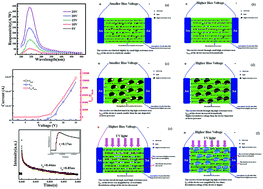High-performance UV detectors based on room-temperature deposited amorphous Ga2O3 thin films by RF magnetron sputtering
Abstract
Room-temperature-fabricated amorphous Ga2O3 is an inexpensive and highly sensitive material for high-performance solar-blind ultraviolet (UV) (220–280 nm) detectors, which are extremely useful given the widespread use of solar-blind UV photoelectronic technology in multiple areas. The UV detection characteristics of room-temperature deposited amorphous Ga2O3 thin films fabricated by a simple RF magnetron sputtering method were studied, and the deposition Ar pressure of an a-Ga2O3 thin film was varied to determine the mechanism underlying high-performance UV detection and to develop an ideal a-Ga2O3 thin film for UV detection. A high-response amorphous Ga2O3-based UV detector was made at 0.5 Pa, and the maximum response of the device reached 436.3 A W−1 under 240 nm UV light with a 25 V bias voltage, which is near the maximum values for a single-crystal β-Ga2O3 material deposited at a high temperature. An amorphous Ga2O3-based UV detector with a low Idark noise level (4.9 nA at 25 V) and a high Iuv/Idark ratio (107314.4) was made at 1.2 Pa, and the Iuv/Idark ratio of the device was near that of a UV detector based on single-crystal β-Ga2O3 with a complex metal-oxide–semiconductor field-effect transistor (MOSFET) structure. Through a comparative analysis of the electrical characteristics and the gain mechanism within amorphous Ga2O3 thin films deposited at different Ar pressures, the high UV response of the amorphous Ga2O3 detector at 0.5 Pa is found to mainly result from the quasi-Zener tunneling multiplication phenomenon between different resistance components. The low Idark value and the high signal-to-noise ratio of the amorphous Ga2O3-based detector deposited at 1.2 Pa were mainly due to more high-resistance components and a relatively higher tunneling gain in the device. In addition, the amorphous Ga2O3-based detectors showed a much shorter response time (0.08 μs for the device deposited at 0.65 Pa) and recovery time (td1 = 0.21 ms, td2 = 5.88 ms for the device deposited at 1.2 Pa) than the reported crystal semiconductor-based devices and multiple complex structure devices. Thus, the room-temperature-fabricated amorphous Ga2O3 thin film could quickly and effectively detect a faint UV light signal in the presence of a very noisy background, which is extremely important in the applications of UV detectors in wearable, flexible photoelectronic devices.



 Please wait while we load your content...
Please wait while we load your content...